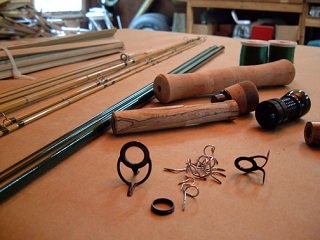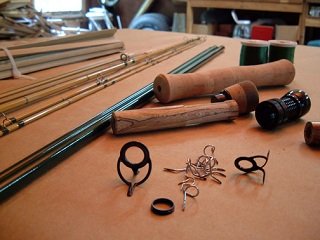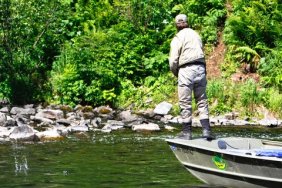 There are hundreds upon hundreds of rods available on the market today, but sometimes an angler wants something custom-fitted to their own style or tastes. Sometimes you can pull a quality rod from the rack at an outdoor retail store and immediately feel comfortable with it, but some anglers wish to go the extra mile and actually hand-craft their own rod. I know at first this sounds like a highly-involved and delicate task, and it is, but that doesn’t mean it’s impossible. All it takes to create a rod that is truly one of a kind is some time, dedication, creativity, and of course, money.
There are hundreds upon hundreds of rods available on the market today, but sometimes an angler wants something custom-fitted to their own style or tastes. Sometimes you can pull a quality rod from the rack at an outdoor retail store and immediately feel comfortable with it, but some anglers wish to go the extra mile and actually hand-craft their own rod. I know at first this sounds like a highly-involved and delicate task, and it is, but that doesn’t mean it’s impossible. All it takes to create a rod that is truly one of a kind is some time, dedication, creativity, and of course, money.
Obviously, the first step in creating a rod is figuring out what you’ll be using it for. The species will determine the components you’ll need to make the ideal rod for your purposes. When choosing a blank, it’s important to consider the following: lures, species, location, reel style, etc. Also, you’ll want to take some time to decide what type of material—fiberglass, graphite, or composite—you’ll want to go with.
Once you’ve decided on the blank, next comes the grip. Typically made of cork or foam, you’ll need to choose a style, length, and shape that work for you. Foam grips are very durable, but cork grips allow you to feel subtle nibbles and bites better, so those are factors to consider when making your decision. Again, the particulars really depend on what you’ll be using the rod for. Casting large lures may require a longer, or even a split-grip, handle, for example.
Next it’s time to choose guides. Double foot guides are stronger, but single foot guides are optimal for lighter weight and precision. Also, ring material is important, as it will dictate your casting. Abrasive line, especially thin braid, will require stronger material, like titanium carbide. Common materials for general fishing include alconite and hialoy. If you’re concerned with the overall aesthetics of your rod, then I suggest matching the guide color with the reel seat.
Other components include wrapping thread, which can be as intricately or simply applied as you like. It really depends on how much work you’re willing to put into the design of the rod. You’ll also need wrapping finish, which is a clear coating used to seal and lock the threading into place.
If you’re interested in building your own rod, then I suggest checking out a catalogue or website where you can obtain the necessary components. Jann’s Netcraft is a great place to start. I’ve known a few people who have used the company for rod and lure building and swear by it. Rod building can be as creative as you like. For instance, I knew a professional angler who made a rod designed for flipping and pitching, in which the guides actually spiraled as they ran down the blanks. This is due to the way anglers hold a rod while using the tactic. The possibilities are nearly endless, especially when it comes to overall design, so don’t be afraid to experiment and ask questions as you go along. Also, one last thing, don’t forget to put your signature on the rod once it’s finished. After all, it’s a one of a kind creation.








